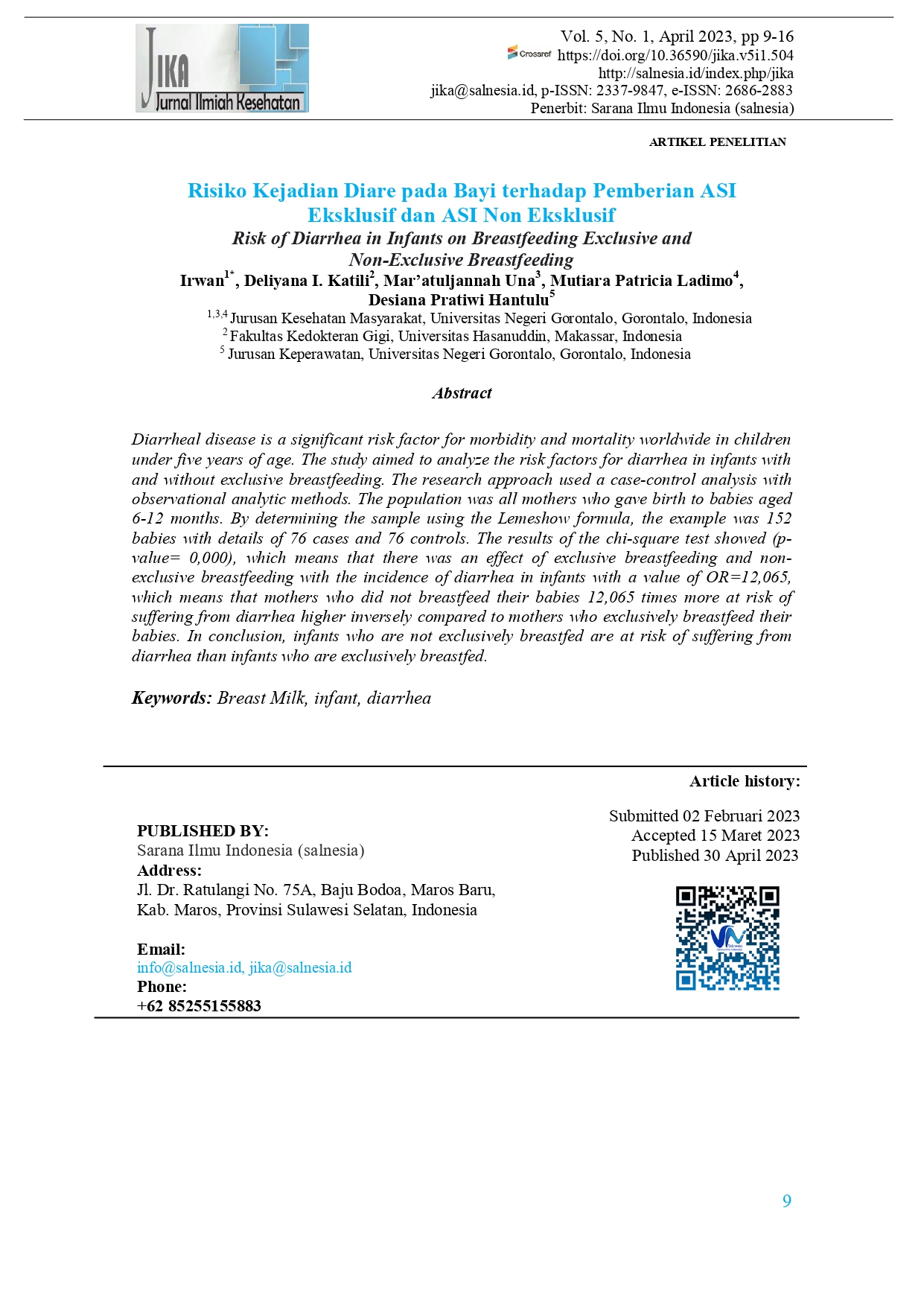Risk of Diarrhea in Infants on Breastfeeding Exclusive and Non-Exclusive Breastfeeding
DOI:
https://doi.org/10.36590/jika.v5i1.504Keywords:
Breast Milk, infant, diarrheaAbstract
Diarrheal disease is a significant risk factor for morbidity and mortality worldwide in children under five years of age. The study aimed to analyze the risk factors for diarrhea in infants with and without exclusive breastfeeding. The research approach used a case-control analysis with observational analytic methods. The population was all mothers who gave birth to babies aged 6-12 months. By determining the sample using the Lemeshow formula, the example was 152 babies with details of 76 cases and 76 controls. The results of the chi-square test showed (p-value= 0,000), which means that there was an effect of exclusive breastfeeding and non-exclusive breastfeeding with the incidence of diarrhea in infants with a value of OR=12,065, which means that mothers who did not breastfeed their babies 12,065 times more at risk of suffering from diarrhea higher inversely compared to mothers who exclusively breastfeed their babies. In conclusion, infants who are not exclusively breastfed are at risk of suffering from diarrhea than infants who are exclusively breastfed.
Downloads
References
Analinta A. 2019. Hubungan Antara Pemberian Asi Eksklusif dengan Kejadian Diare Pada Balita di Kelurahan Ampel, Kecamatan Semampir, Kota Surabaya 2017. Amerta Nutrition, 3(1): 13. https://doi.org/10.20473/amnt.v3i1.2019.13-17.
Haile ZT, Elmasry M, Chavan B, Azulay Chertok IR. 2017. Association Between Type of Health Professional at Birth and Exclusive Breastfeeding. Journal of Midwifery and Women’s Health, 62(5): 562–571. https://doi.org/10.1111/jmwh.12657.
Hazir T, Akram DS, Nisar Y Bin, Kazmi N, Agho KE, Abbasi S, Khan AM, Dibley MJ. 2013. Determinants of suboptimal breast-feeding practices in Pakistan. Public Health Nutrition, 16(4): 659–672. https://doi.org/10.1017/S1368980012002935.
Horta BL, Victora CG. 2013. Short-term effects of breastfeeding A Systematic Review On The Benefits Of Breastfeeding on Diarrhoea and Pneumonia Mortality. WHO.
Julinar, Isfanda, Safira U. 2023. Hubungan Pemberian ASI Eksklusif dengan kejadian diare di RSIA Banda Aceh. Jurnal Ilmu Kedokteran dan Kesehatan, 10(1): 1426–1430.
Kadir S, Irwan I, Mertosono DJ. 2022. The differences of exclusive breastfeeding in review of working and not working parenting patterns at the health center of kabila bone. Journal Health & Science?: Gorontalo Journal Health and Science Community, 6(2): 109–120. https://doi.org/10.35971/gojhes.v5i3.13777.
Kurniawan RE, Makrifatullah NA, Rosar N, Triana Y, Kunci K. 2022. Perbandingan Angka Kejadian Diare Pada Anak Usia 3-5 Tahun dengan Riwayat Pemberian Asi Eksklusif dan Asi Non Eksklusif di Wilayah Kerja Puskesmas Jongaya. Jurnal Ilmiah Multi Disiplin Indonesia, 2(1): 163–173.
Puskesmas Pilolodaa. 2019. Profil Kesehatan Pilolodaa. Gorontalo: Puskesmas Pilolodaa.
Kemenkes Gorontalo. 2018. Laporan Provinsi Gorontalo Riskesdas 2018. Gorontalo: Kemenkes.
Roostaee F, Tabatabaei S, Zaboli M, Keykhaie R, SharifiRad J, Shahrak P, Soroush F. 2015. Breast-feeding Continuation in South-Eastern of Iran: the Associated Factors. Medical Archives, 69(2): 98. https://doi.org/10.5455/medarh.2015.69.98-102.
Rusyda F, Ronoatmodjo S. 2021. The Relationship between Exclusive Breastfeeding and Diarrhea in Under Six Months Infants in 2017 (Analysis of Indonesian Health Demography Data Survey 2017). Jurnal Epidemiologi Kesehatan Komunitas, 6(2): 333–340. https://doi.org/10.14710/jekk.v6i2.11815.
Saeed OB, Haile ZT, Chertok IA. 2020. Association Between Exclusive Breastfeeding and Infant Health Outcomes in Pakistan. Journal of Pediatric Nursing. Elsevier Inc., 50(xxxx): e62–e68. https://doi.org/10.1016/j.pedn.2019.12.004.
Simatupang EJ, Novrida Y, Djami MEU, Pusmaika R, Enjelia D, Romladhoni A, Kusumawati I, Kebidanan A, Husada B, Keperawatan A, Jakarta A. 2022. Hubungan Asi Eksklusif dengan Kejadian Diare Pada Batita di Kabupaten Tangerang. Prepotif Jurnal Kesehatan Masyarakat, 6: 1730–1737.
Srivastava S, Shankar Mishra P, Sinha D, Kumar P. 2020. Population attributable risk for breastfeeding practices on diarrhea and acute respiratory infections among children aged 0–23 months in India – What we know and we do not know? Children and Youth Services Review. Elsevier, 119: 105531. https://doi.org/10.1016/j.childyouth.2020.105531.
Sultana M, Dhar S, Hasan T, Chandra L, Islam A, Das S. 2022. Knowledge, attitudes, and predictors of exclusive breastfeeding practice among lactating mothers in Noakhali, Bangladesh Marjia. Heliyon, 8(10). https://doi.org/10.1016/j.heliyon.2022.e11069.
Syahroni SZS, Souvriyanti E, Arifandi F. 2022. Hubungan Pemberian Asi Eksklusif dan Asi Non Eksklusif terhadap Kejadian Diare Pada Anak Usia 0-24 Bulan. Cerdika: Jurnal Ilmiah Indonesia, 2(10): 864–873.
Victora CG, Bahl R, Barros AJD, França GVA, Horton S, Krasevec J, Murch S, Sankar MJ, Walker N, Rollins NC, Allen K, Dharmage S, Lodge C, Peres KG, Bhandari N, Chowdhury R, Sinha B, Taneja S, Giugliani E, Horta B, Maia F, de Mola CL, Hajeebhoy N, Lutter C, Piwoz E, Martines JC, Richter L. 2016. Breastfeeding in the 21st century: epidemiology, mechanisms, and lifelong effect. The Lancet. Elsevier Ltd, 387(10017): 475–490. https://doi.org/10.1016/S0140-6736(15)01024-7.
Wardani NME, Witarini KA, Putra PJ, Artana IWD. 2022. Pengaruh Pemberian ASI Eksklusif terhadap Kejadian Diare pada Anak Usia 1-3 Tahun. Jurnal Medika Udayana, 11(01): 12–17.
WHO, UNICEF. 2019. Global Breastfeeding Scorecard. Enabling Women to Breastfeed Through Better Policies and Programmes. WHO/Unicef, (3):3.
Wright MJ, Mendez MA, Bentley ME, Adair LS. 2017. Breastfeeding modifies the impact of diarrhoeal disease on relative weight: a longitudinal analysis of 2-12 month-old Filipino infants. Maternal & Child Nutrition, 13(2): e12312. https://doi.org/10.1111/mcn.12312.
Yofrido, Filipus, Michael. 2020. The Relationship Between Breastfeeding Patterns And Incidence of Diarrhea in Children Aged 7-23 Months. https://doi.org/https://doi.org/10.33508/jwm.v5i2.220 7.
Zil-e-Huma, Tareen AM, Samad A, Mustafa MZ, Maryam M, Rizwan S, Akbar A. 2022. Immunogenic protein profiling of pathogenic Escherichia coli strains isolated from infants with diarrhea in Quetta Balochistan. Journal of King Saud University - Science, 34(3): 101883. https://doi.org/10.1016/j.jksus.2022.101883.

Downloads
Published
How to Cite
Issue
Section
License
Copyright (c) 2023 Irwan, Mar’atuljannah Una, Deliyana I. Katili, Mutiara Patricia Ladimo, Desiana Pratiwi Hantulu

This work is licensed under a Creative Commons Attribution 4.0 International License.








